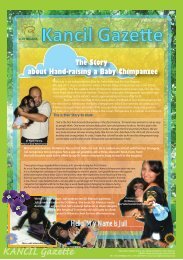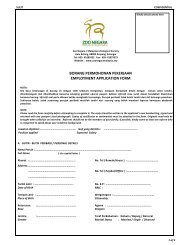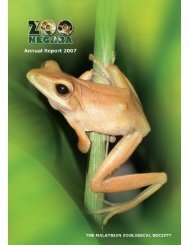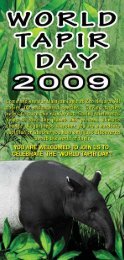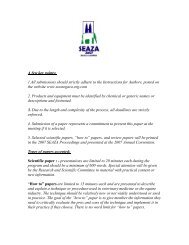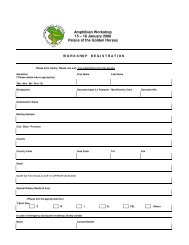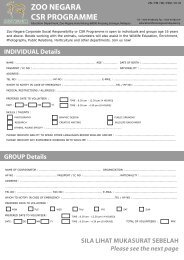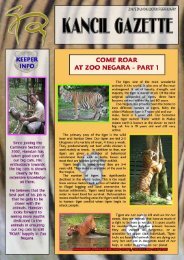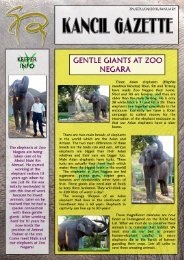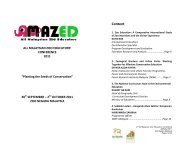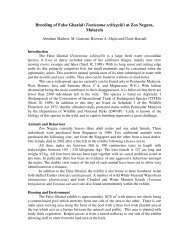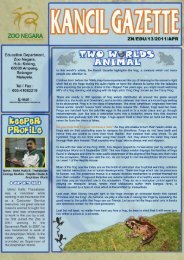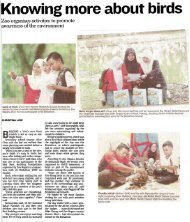COVER ANNUAL REPORT 2008.psd - Zoo Negara
COVER ANNUAL REPORT 2008.psd - Zoo Negara
COVER ANNUAL REPORT 2008.psd - Zoo Negara
You also want an ePaper? Increase the reach of your titles
YUMPU automatically turns print PDFs into web optimized ePapers that Google loves.
Heliconiaceae<br />
Heliconia rostrata<br />
PARK & GARDENs<br />
Landscaping is an ongoing job at the zoo<br />
with planting and replanting to add in new<br />
species of plants and create new<br />
landscaped areas to provide for an<br />
interesting, safe, comfortable and<br />
refreshing environment for visitors, zoo<br />
workers and animals. The scattered and<br />
continuous planted borders complement<br />
the tall, old leafy trees that provide plenty<br />
of restful shade for all.<br />
LANDSCAPING PROGRAMME<br />
The Shrub pseuderanthemum ‘Jessica’<br />
with prominent red leaves has been<br />
planted in front of the Flamingo exhibit to<br />
give an interesting visual impact.<br />
This is off-set by a ground cover plant,<br />
Pandanus pygmaeus, with pointed yellow<br />
leaves edged with green lines.<br />
Cordyline fruticosa ‘Firebrand’ that has<br />
wide leaves with dark red in the middle is<br />
paired with Ophiopogon jaburan which<br />
has fine green leaves; both plants now<br />
decorate the area in front of the Sumatran<br />
Tiger exhibit next to tram station no. 4, in<br />
place of the older plants.<br />
Outside the Ankole Cattle’s exhibit<br />
overlooking Savannah Walk Heliconia<br />
humilis, Helicona bihai and Heliconia<br />
rostrata have been planted to cover the<br />
iron fencing so as to enhance the open<br />
concept of the Savannah Walk.<br />
Moreover, the plant has beautiful flowers<br />
that resemble red crab forceps with<br />
yellow edging.<br />
Hibiscus sp. shrubs were added at a<br />
few places with a substantial presence<br />
along the roadside leading to the old<br />
office building and the Veterinary<br />
Hospital. Some are placed at the Bird<br />
House area and the Multi-animal Show<br />
Amphitheatre.<br />
The overgrown palm, Rhapis excelsa<br />
were relocated from the Picnic Area in<br />
front of the Walls Café that it had<br />
caused less visibility to visitors.<br />
Some of it was relocated to cover the<br />
fence between Wild Restaurant and<br />
the Bee Museum while the remainder<br />
was transferred to the corner between<br />
the Elephant exhibit and wall bordering<br />
the FINAS building.<br />
ROTUNDA BUILDING<br />
Previously, a seasonal plant, Celosia sp.<br />
was planted in the plant box outside the<br />
Rotunda building. The plant normally<br />
lasts for only two to three months. Added<br />
to this handicap, visitors like to pick the<br />
flowers whenever they sit on the edge of<br />
the box. Because of this, the plant has<br />
been replaced with the more appropriate<br />
Mother-in-law tongue (pokok lidah jin) or<br />
its scientific name Sansevieria trifasciata<br />
‘Laurenti’. It has long leaves like a tongue<br />
and yellow color in the middle with green<br />
lines at the edge. Restless fingers will<br />
now find no flowers to pluck here.<br />
Another plant box next to it was planted<br />
with Cuphea hyssopifolia and Codiaeum<br />
sp. (pokok puding) with yellow thin<br />
leaves. Some of these plants that have<br />
died have now been replaced with the<br />
same genus of plants.<br />
13




